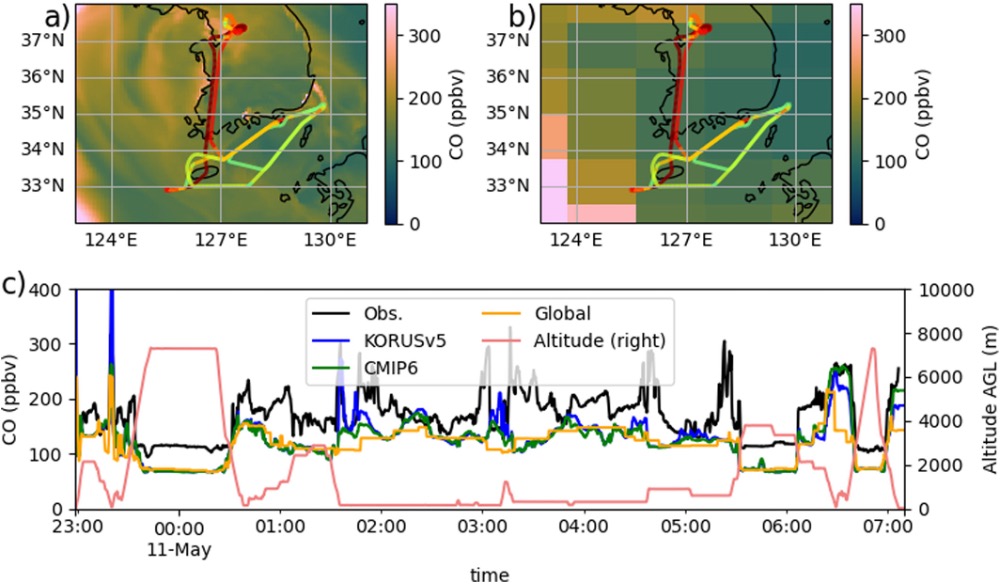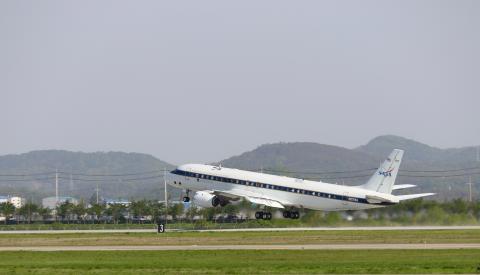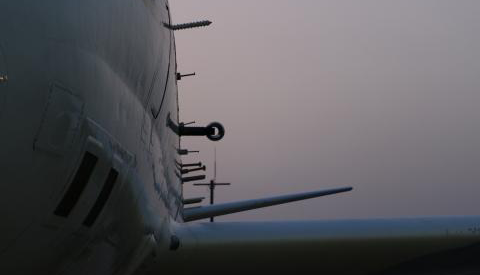Predicting air pollution effects on the weather
Lauren Smith
Nov 20, 2023

Simulated and observed carbon monoxide concentrations on 11 May 2016. Subfigures (a and b) show the regional model with KORUSv5 emissions and the global model approximately 50 m above the surface at 0300 UTC (1200 local time). Subfigure (c) shows the timeseries simulated by the global and regional models with the two emissions inventories (as indicated in the legend), compared to measurements from the in situ diode laser spectrometer (DACOM) on the aircraft. J Adv Model Earth Syst, Volume: 15, Issue: 11, First published: 08 November 2023, DOI: (10.1029/2022MS003457)
Many people rely on daily weather predictions without realizing that meteorologists usually don't try to predict how variations in air pollution might impact weather.
Most existing models for weather forecasting do not represent aerosols, also known as atmospheric particles, in detail. Aerosol-radiation and aerosol-cloud interactions affect temperatures on Earth by changing the brightness of clouds and the radiation reflected back to the sun.
Researchers at Carnegie Mellon University have developed a system for using a climate model to predict how air pollutants affect the weather at fine grid resolution, the scale needed for accurate regional weather forecasts.
For the last 30 years, atmospheric scientists at the UK Met Office have used a global climate model, designed for long-duration simulations, to simulate how air pollution will evolve and influence climate over hundreds of years. Some of this code, without any detailed representation of air pollution, is also used for forecasting the weather over periods of a few days.
To represent how the atmosphere behaves, for example the flow of moisture in the atmosphere as moved by the wind, the climate model splits the atmosphere into boxes. The challenge is that a model run at fine grid resolution, with very small boxes, requires a lot of computing power. It is less expensive to run the model with very large boxes. That approach, however, results in insufficiently detailed weather forecasts. Things like mountains get smeared out.
Hamish Gordon and his collaborators designed a setup of the climate model that adds the capability to simulate air pollutants (aerosols and trace gases such as ozone) in simulations like weather forecasts that use very small boxes. To decrease computing costs, Gordon, an assistant professor of chemical engineering, nested regional models within the global model.
The system has been used successfully to predict visibility in Delhi, India, for several years. "In Delhi, air pollutant concentrations change a lot on short time scales and over small spatial scales. Therefore this high level of detail is really needed to predict visibility," says Gordon.
In a new paper published in the Journal of Advances in Modeling Earth Systems, Gordon describes and fully tests the framework of the model, known as NUMAC (Nested Unified Model with Aerosols and Chemistry).
In addition to predicting air pollution effects on the weather, the new system will allow climate scientists to study atmospheric processes involving air pollutants in more detail. "It's a way of visualizing and testing representations of different atmospheric processes in climate models," says Gordon.
With the new system, simulations can also be evaluated more precisely. The scale of the simulations is more similar to real-world observations than in a typical global climate model. The model can be tested in much more detail than it can when running a simulation of the whole globe using large grid boxes.
The work was a collaboration between CMU, the UK Met Office, and the University of Leeds, with funding from NASA. To test the model, Gordon used aircraft measurements from NASA's Korea-United States Air Quality campaign over South Korea in 2016. Simulations and data analysis were done at the Pittsburgh Supercomputing Center.
"Because of this nice comparison with the measurements made in Korea," says Gordon, "we have a fair idea where the model does well and where it does badly. We will use that comparison to point the way forward." Gordon's research group is interested in finding out which processes must be represented in detail to predict weather and air quality accurately, understanding these processes better, and devising new ways to treat them in the climate model.
For media inquiries, please contact Lauren Smith at lsmith2@andrew.cmu.edu.


